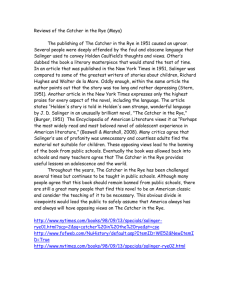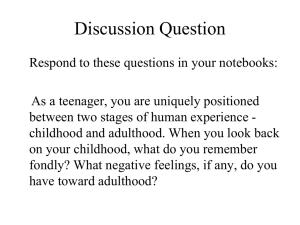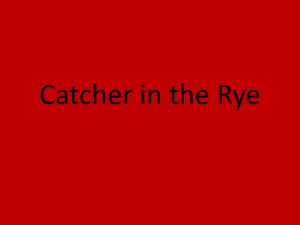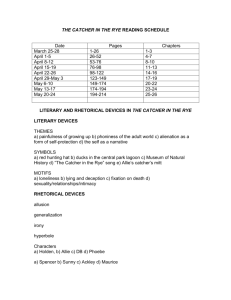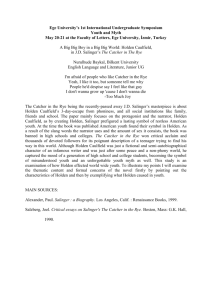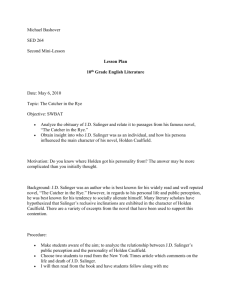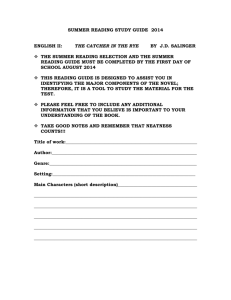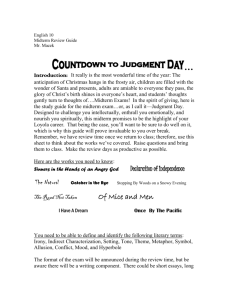Newspaper article JD Salinger
advertisement
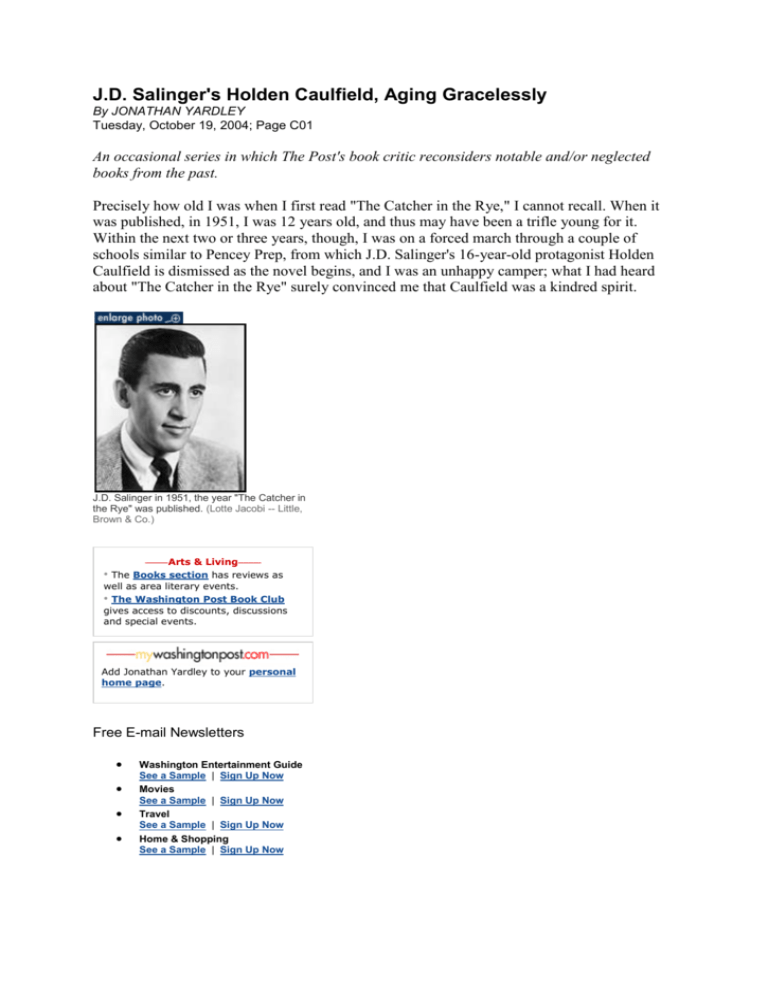
J.D. Salinger's Holden Caulfield, Aging Gracelessly By JONATHAN YARDLEY Tuesday, October 19, 2004; Page C01 An occasional series in which The Post's book critic reconsiders notable and/or neglected books from the past. Precisely how old I was when I first read "The Catcher in the Rye," I cannot recall. When it was published, in 1951, I was 12 years old, and thus may have been a trifle young for it. Within the next two or three years, though, I was on a forced march through a couple of schools similar to Pencey Prep, from which J.D. Salinger's 16-year-old protagonist Holden Caulfield is dismissed as the novel begins, and I was an unhappy camper; what I had heard about "The Catcher in the Rye" surely convinced me that Caulfield was a kindred spirit. J.D. Salinger in 1951, the year "The Catcher in the Rye" was published. (Lotte Jacobi -- Little, Brown & Co.) _____Arts & Living_____ • The Books section has reviews as well as area literary events. • The Washington Post Book Club gives access to discounts, discussions and special events. Add Jonathan Yardley to your personal home page. Free E-mail Newsletters Washington Entertainment Guide See a Sample | Sign Up Now Movies See a Sample | Sign Up Now Travel See a Sample | Sign Up Now Home & Shopping See a Sample | Sign Up Now By then "The Catcher in the Rye" was already well on the way to the status it has long enjoyed as an essential document of American adolescence -- the novel that every high school English teacher reflexively puts on every summer reading list -- but I couldn't see what all the excitement was about. I shared Caulfield's contempt for "phonies" as well as his sense of being different and his loneliness, but he seemed to me just about as phony as those he criticized as well as an unregenerate whiner and egotist. It was easy enough to identify with his adolescent angst, but his puerile attitudinizing was something else altogether. That was then. This is half a century later. "The Catcher in the Rye" is now, you'll be told just about anywhere you ask, an "American classic," right up there with the book that was published the following year, Ernest Hemingway's "The Old Man and the Sea." They are two of the most durable and beloved books in American literature and, by any reasonable critical standard, two of the worst. Rereading "The Catcher in the Rye" after all those years was almost literally a painful experience: The combination of Salinger's execrable prose and Caulfield's jejune narcissism produced effects comparable to mainlining castor oil. Over that half-century I'd pretty much forgotten about "The Catcher in the Rye," though scarcely about Salinger, whose celebrated reclusiveness has had the effect of keeping him in the public eye. He has published no books since "Raise High the Roof Beam, Carpenters and Seymour: An Introduction" in 1963, but plenty has been published about him, including Ian Hamilton's decidedly unauthorized biography, "In Search of J.D. Salinger" (1988); Joyce Maynard's self-serving account of her affair with him, "At Home in the World" (1998); and his daughter Margaret A. Salinger's (also self-serving) memoir, "Dream Catcher" (2000), not to mention reams of lit crit and fanzine fawning. Rumors repeatedly make their way across the land that Salinger is busily at his writing table, that his literary fecundity remains undiminished, that bank vaults in New England contain vast stores of unpublished Salingeriana, but to date all the speculation has come to naught, for which we should -though too many people won't -- be grateful. If there's an odder duck in American literature than Salinger, his or her name doesn't come quickly to mind. He started out conventionally enough -- born in Manhattan in 1919, served (valiantly) in the infantry in Europe during World War II, wrote short stories that were published in respectable magazines, notably the New Yorker -- but he seems to have been totally undone by the fame that "The Catcher in the Rye" inflicted upon him. For nearly four decades he has been a semi-hermit (he married for the third time about a decade and a half ago) in his New England fastness, spurning journalists and fending off adoring fans, practicing the Zen Buddhism that seems to have become an obsession with him. It's weird, but it's also his business. If, Garbolike, he just vants to be alone, he's entitled. But whether calculated or not, his reclusiveness has created an aura that heightens, rather than diminishes, the mystique of "The Catcher in the Rye." It isn't just a novel, it's a dispatch from an unknown, mysterious universe, which may help explain the phenomenal sales it enjoys to this day: about 250,000 copies a year, with total worldwide sales over -- probably way over -10 million. The mass-market paperback I bought last summer is, incredibly, from the 42nd printing; for the astonishing price of $35,000 you can buy, online, a signed copy not of the first edition -- a signed copy of that, we must assume, would be almost literally priceless -but of the 1951 Book-of-the-Month Club edition. Viewed from the vantage point of half a century, the novel raises more questions than it answers. Why is a book about a spoiled rich kid kicked out of a fancy prep school so widely read by ordinary Americans, the overwhelming majority of whom have limited means and attend, or attended, public schools? Why is Holden Caulfield nearly universally seen as "a symbol of purity and sensitivity" (as "The Oxford Companion to American Literature" puts it) when he's merely self-regarding and callow? Why do English teachers, whose responsibility is to teach good writing, repeatedly and reflexively require students to read a book as badly written as this one? That last question actually is easily answered: "The Catcher in the Rye" can be fobbed off on kids as a book about themselves. It is required reading as therapy, a way to encourage young people to bathe in the warm, soothing waters of resentment (all grown-ups are phonies) and self-pity without having to think a lucid thought. Like that other (albeit marginally better) novel about lachrymose preppies, John Knowles's "A Separate Peace" (1960), "The Catcher in the Rye" touches adolescents' emotional buttons without putting their minds to work. It's easy for them, which makes it easy for teacher. What most struck me upon reading it for a second time was how sentimental -- how outright squishy -- it is. The novel is commonly represented as an expression of adolescent cynicism and rebellion -- a James Dean movie in print -- but from first page to last Salinger wants to have it both ways. Holden is a rebel and all that -- "the most terrific liar you ever saw in your life," "probably the biggest sex maniac you ever saw" -- but he's a softy at heart. He's always pitying people -- "I felt sorry as hell for him, all of a sudden," "You had to feel a little sorry for the crazy sonuvabitch," "Real ugly girls have it tough. I feel so sorry for them sometimes" -- and he is positively a saint when it comes to his little sister, Phoebe. He buys a record for her, "Little Shirley Beans," and in the course of moping around Manhattan he does something clumsy that gives him the chance to show what a good-hearted guy he really is: "Then something terrible happened just as I got in the park. I dropped old Phoebe's record. It broke into about fifty pieces. It was in a big envelope and all, but it broke anyway. I damn near cried, it made me feel so terrible, but all I did was, I took the pieces out of the envelope and put them in my coat pocket. They weren't good for anything, but I didn't feel like just throwing them away. Then I went in the park. Boy, was it dark." Me, I damn near puked. That passage is flagrantly manipulative, a tug on the heartstrings aimed at bringing a tear to the eye. Ditto for Holden's brother, Allie: "He's dead now. He got leukemia and died when we were up in Maine, on July 18, 1946. You'd have liked him. He was two years younger than I was, but he was about fifty times as intelligent. He was terrifically intelligent. His teachers were always writing letters to my mother, telling her what a pleasure it was having a boy like Allie in their class. And they weren't just shooting the crap. They really meant it." That's just easy exploitation of the reader's emotion. Give your protagonist a dead younger brother and a cute little sister -- not to mention a revered older brother, D.B., a gifted writer who sounds a whole lot like J.D. Salinger himself -- and the rest is strictly downhill. From first page to last, "The Catcher in the Rye" is an exercise in button-pushing, and the biggest button it pushes is the adolescent's uncertainty and insecurity as he or she perches precariously between childhood, which is remembered fondly and wistfully, and adulthood, which is the great phony unknown. Indeed a case can be made that "The Catcher in the Rye" created adolescence as we now know it, a condition that barely existed until Salinger defined it. He established whining rebellion as essential to adolescence and it has remained such ever since. It was a short leap indeed from "The Catcher in the Rye" to "The Blackboard Jungle" to "Rebel Without a Cause" to Valley Girls to the multibillion-dollar industry that adolescent angst is today. The cheap sentimentality with which the novel is suffused reaches a climax of sorts when Holden's literary side comes to the fore. He flunks all his courses except English. "I'm quite illiterate," he says early in the book, "but I read a lot," which establishes the mixture of selfdeprecation and self-congratulation that seems to appeal to so many readers. In one of the novel's more widely quoted passages he then says: "What really knocks me out is a book that, when you're all done reading it, you wish the author that wrote it was a terrific friend of yours and you could call him up on the phone whenever you felt like it. That doesn't happen much, though. I wouldn't mind calling this Isak Dinesen up. And Ring Lardner, except that D.B. told me he's dead." That Ring Lardner is one of Holden's favorite writers is a considerable, if wholly inadvertent, irony. Lardner was the master of the American vernacular who, as H.L. Mencken wrote, "set down common American with the utmost precision." Salinger, by contrast, can be seen straining at every turn to write the way an American teenager would speak, but he only produces an adult's unwitting parody of teen-speak. Unlike Lardner, Salinger has a tin ear. His characters forever say "ya" for "you," as in "ya know," which no American except perhaps a slapstick comedian ever has said. Americans say "yuh know" or "y'know," but never "ya know." "The Catcher in the Rye" is a maladroit, mawkish novel, but there can be no question about its popularity or influence. My own hunch is that the reason is the utter, innocent sincerity with which it was written. It may be manipulative, but it's not phony. A better, more cynical writer than Salinger easily could write a book about a troubled yet appealing teenager, but its artifice and insincerity would be self-evident and readers would reject it as false. Whatever its shortcomings, "The Catcher in the Rye" is from the heart -- not Holden Caulfield's heart, but Jerome David Salinger's. He said everything he had to say in it, which may well be why he has said nothing else. "The Catcher in the Rye" is available in a $5.99 mass-market paperback (Little, Brown) and a $13.95 trade paperback (Back Bay Books) that reproduces the original dust jacket. Jonathan Yardley's e-mail address is yardleyj@washpost.com.
